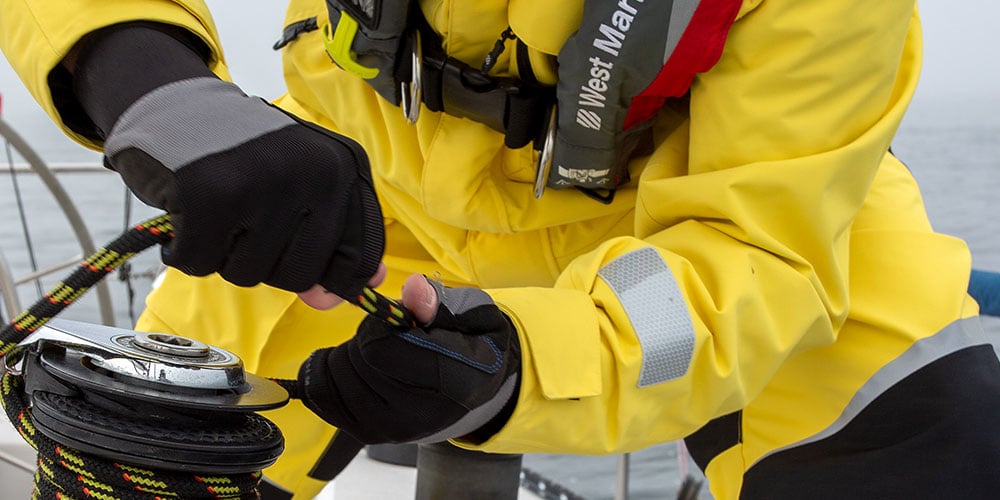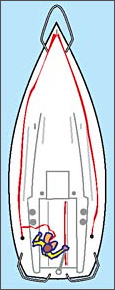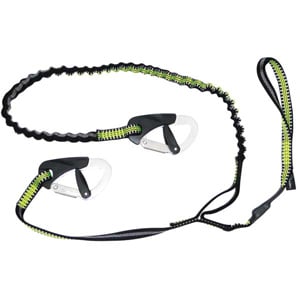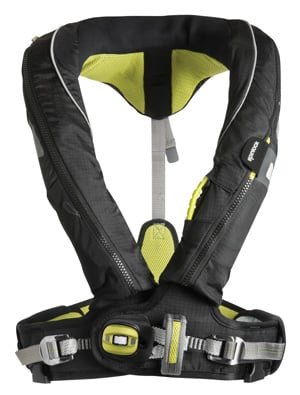
Harnesses and Jacklines Keep You On Deck

Safety harnesses physically connect you to the boat to prevent you from falling overboard or, failing in that role, are intended to keep you from being separated from the boat. Harnesses are either stand-alone items or are integrated with offshore type inflatable life vests. Tethers clip you to a fixed-location padeye or to jacklines (also called trolley lines or jack stays) that are lengths of rope, webbing or wire running fore and aft or athwartships. Jacklines can be run on the boat’s centerline, along each side deck or secured inside the cockpit.
For years customers bought foam life jackets, safety harnesses, and tethers when they equipped their boats to go offshore. This has changed dramatically with the introduction of the combination safety harness and inflatable life jacket. In virtually all conditions where you would elect to wear a safety harness, you would also elect to wear a life jacket, which is why many boaters choose a PFD that combines the two.
Another reason to wear harnesses integrated with inflatables is that it's very difficult to find a combination of separate life jackets and harnesses that don’t interfere with one another. It’s also time consuming to prepare to come on deck when you have to juggle such things as foul weather gear, gloves, a hat, a life jacket and a seperate harness. We prefer the simplicity of putting on one piece of safety gear with all of the components built-in.
World Sailing Requirements
Explanation of Tether Components

Snap Shackle: Easy to release under load, but can be released accidentally if the lanyard is pulled. Best for the harness end of the tether.

Snap Hook: Easy to attach, difficult to detach under load. Although designed to reduce accidental release from padeyes and deck attachments, accidental releases can sometimes occur.

Double-Action Safety Hook: Easy to attach and detach. Lightweight aluminum hook locks closed automatically and will not come undone accidentally. Easy to release with one ergonomic hand movement.
World Sailing includes the following warning in Section 5.02 of their 2016–2017 Offshore Special Regulations for sailboat racing: “Warning: it is possible for a plain snap hook to disengage from a U-bolt if the hook is rotated under load at right-angles to the axis of the U-bolt. For this reason, the use of snap hooks with positive locking devices is strongly recommended.” Our World Sailing-Specification Tethers meet these requirements with snap-hooks that cannot accidentally release but are simple to manually disengage.
World Sailing-Spec tethers also include indicator flags stitched into their webbing that show if the tether has been overloaded, compromising its strength. These function like the little green dot in the inflators of some inflatable PFDs that show when the device is armed and ready and are a simple visual indicator. The regulations state: “a safety line purchased in January 2001 or later shall have a colored flag embedded in the stitching, to indicate an overload. A line which has been overloaded shall be replaced as a matter of urgency.”
Jackline Considerations
Jacklines should be at least as strong as your safety harness since the strain on them is greater. They are commonly made from nylon webbing treated to resist UV degradation, but nylon stretches too much, allowing too much range of motion when crewmembers are clipped to it.
Therefore, we recommend either using low-stretch braid like V-12 or Amsteel, or polyester webbing jacklines from West Marine (which are easier on your feet than stepping on round line, and won’t roll under your feet and knock you off balance). Any of those alternatives will dramatically reduce the distance that the jacklines can be pulled off-center, which can contribute to keeping your crew on deck where they belong.
I sail in coastal and offshore races regularly on my Cal 40 and an Antrim 27 sportboat, and our jacklines are polyester webbing. Because this stuff is stretchy, we run a purchase system of AmSteel Dyneema loops and cinch the after end up tight. This system has worked well for keeping my crew onboard.
Tether Considerations

Spinlock Deckware Double Safety Tether attaches to your harness with a cow hitch. It is the lightest and most comfortable tether, but you need a knife to cut it loose in an emergency.

An inflatable offshore PFD with harness like the DeckVest™ 5D from Spinlock is comfortable to wear and keeps you from being separated from the boat.
Be sure that your safety tether isn’t so long that you could get thrown overboard while you’re clipped onto something. World Sailing includes this warning in Section 5.06.6 of the Offshore Special Regs: “Warning - a safety line and safety harness are not designed to tow a person in the water and it is important that the shortest safety line length possible be used with a harness to minimize or eliminate the risk of a person's torso becoming immersed in water outside the boat, especially when working on the foredeck. One meter safety lines or the midpoint snap hook on a 2m line should be used for this purpose. The diligent use of a properly adjusted safety harness and the shortest safety line practicable is regarded as by far the most effective way of preventing man overboard incidents.”
Double tethers, with one 6' tether and one 3' tether, are the best way to solve this problem. You can use the long tether when you’re moving about the boat and hooked onto a jackline. Clip on with the shorter tether if you’re working on the bow or other stationary location. I stuff the unused tether in the front pocket of my foul weather bibs, so it won’t accidentally hook onto a shroud or other object.
Two double tether choices are available. The West Marine World Sailing-Specification Double Safety Tether clips onto your safety harness with a snap shackle. If you need to unclip in a hurry (as might happen when your boat suddenly turtles after losing its keel) you just need to grab the lanyard and open the shackle. The Spinlock Deckware Safety Tether is lighter and less clunky than the West Marine product, but it attaches to your harness using a sewn loop called a "cow hitch". If you need to disengage it from your body, you have to cut the tether away. If you have a rigging knife on your person as the Offshore Special Regs require, and if in a moment where you’re likely to panic you remember it, you can cut yourself free.
Spinlock’s Automatic Inflatable DeckVest™ 5D with Harness, the companion life vest designed to work with their double tether, includes an Emergency Safety Line Cutter in a pocket of the vest. This PFD is comfortable and ergonomic. I wear it but I use the West Marine Double Tether so I can release it in an emergency.